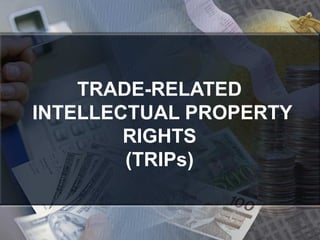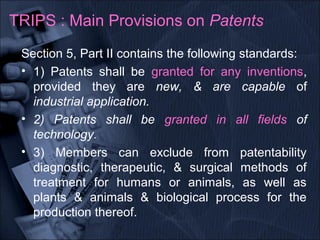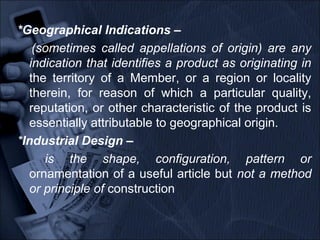Trips
- 2. The agreement covers five broad issues âĒ How basic principles of the trading system and other international intellectual property agreements should be applied âĒ How to give adequate protection to intellectual property rights âĒ How countries should enforce those rights adequately in their own territories âĒ How to settle disputes on intellectual property between members of the WTO âĒ Special transitional arrangements during the period when the new system is being introduced.
- 3. WTO TRIPS Agreement âĒ It is the GATT Uruguay Round Agreement on âTrade Related Intellectual Propertyâ. âĒ It deals with the protection & enforcement of âTrade-Relatedâ intellectual property ârightsâ. âĒ It establishes minimum levels of protection that each government has to give to the intellectual property of fellow WTO members
- 4. What is âIntellectual Propertyâ? âĒ Intellectual Property comprises 2 distinct forms: * Literary & Artistic Works * Industrial Property
- 5. âLiterary & Artistic Worksâ * They are books, paintings, musical compositions, plays, operas, movies, radio/tv programs, performances, & other artistic works. How are they Protected? * Protected by âCopyrightâ which provides the individual âauthorâ or âartistâ the exclusive right to do certain things with an âoriginal workâ, including the right to reproduce, publish, perform the work in public, & to make adaptations of it & benefit thereby.
- 6. âIndustrial Propertyâ Industrial Property describes physical matter that is the product of an idea or concept or that is developed specifically for commercial purposes. âIndustrial Propertyâ include? * Patented objects * Trademarks * Industrial Designs * Trade Secrets * Layout-designs of Integrated Circuits * Geographical Indications
- 7. Why Protect âIntellectual Propertyâ? 1) Because one has expend a lot of investment into production of new & innovative products & they have a right, at least for a period of time, to: * have their name associated with their product and/or their authorship associated with it * get paid for their efforts & to recover their investment, & * frustrate the efforts of âfree ridersâ to make money off their efforts & investment whilst not having any input. 2) Protection stimulates creativity and innovation necessary for productivity, competitiveness, and national economic development
- 8. Relevancy of IPR to International Trade & Investment 1) To ensure that IPR enforcement is consistent with free trade principles of effective market access & non-discrimination. 2) Trade will be inhibited (& foreign direct investment frustrated) if the laws of a country do not protect the IPR of its trading partners and/or prospective investors.
- 9. Patent âĒ Patent is the right given to inventors to have protected exclusive use for specified period of time (âtermâ) for making, using, or selling a new, useful, non-obvious invention. âĒ Patents are available for both products & processes. âĒ Patent in the law is a property right and hence, can be gifted, inherited, assigned, sold or licensed
- 10. TRIPS : Main Provisions on Patents Section 5, Part II contains the following standards: âĒ 1) Patents shall be granted for any inventions, provided they are new, & are capable of industrial application. âĒ 2) Patents shall be granted in all fields of technology. âĒ 3) Members can exclude from patentability diagnostic, therapeutic, & surgical methods of treatment for humans or animals, as well as plants & animals & biological process for the production thereof.
- 11. TRIPS : Main Provisions on Patents âĒ 4) Plant varieties shall be protected by patents. âĒ 5) Exclusive rights conferred in the case of product and process patents are defined, subject in the case of imports. âĒ 6) Inventions shall be disclosed in a manner which is sufficiently clear & complete for a skilled person in the art to carry out the invention. âĒ 7) Limited exceptions to the exclusive rights can be defined by national laws (TRIPS Art. 30)
- 12. TRIPS : Main Provisions on Patents âĒ 8) Conditions for granting other uses without authorization of the patent-holder (compulsory licenses) are set forth â Members can determine the grounds to allow such uses. âĒ 9) Revocation/forfeiture of a patent is subject to judicial review. âĒ 10) The term of protection shall be at least 20 years from the date of application
- 13. Copyright âĒ Copyright is the exclusive right to do certain things with an original work, including the right to reproduce, publish, perform the work in public, & to make adaptations of it. âĒ Copyright is a right, which is available for creating an original literary or dramatic or musical or artistic work. âĒ include Cinematographic films and Computer programs and software
- 14. TRIPS: Main Provisions on Copyright âĒ 1) Protection of works covered by the Berne Convention excluding moral rights to the expression âĒ 2) Protection of computer programs as literary works & of compilations of data. âĒ 3) Recognition of rental rights, at least for phonograms, computer programs, & for cinematographic works.
- 15. TRIPS: Main Provisions on Copyright âĒ 4) Exceptions to exclusive rights must be limited to special cases which do not conflict with normal exploitation of the work & do not unreasonably prejudice the legitimate interests of the rights-holder. âĒ 5) Recognition of the 50 year minimum exclusivity term for works âĒ 6) Recognition of rights of performers, producers of phonograms, & broadcasting organizations
- 16. Thank you
- 17. *Trademark â consists of any sign, or combination of signs, capable of distinguishing the goods or services of one person from those of another, including personal names, designs, letters, numerals, colours, figurative elements, shape of goods, or their packaging. TMs include service marks, collective marks, & mayinclude certification marks. *Trade Secrets â are information deriving its value from not beingknown or available to the public competitors, or other parties who might otherwise gain benefit from its disclosure or use.
- 18. *Geographical Indications â (sometimes called appellations of origin) are any indication that identifies a product as originating in the territory of a Member, or a region or locality therein, for reason of which a particular quality, reputation, or other characteristic of the product is essentially attributable to geographical origin. *Industrial Design â is the shape, configuration, pattern or ornamentation of a useful article but not a method or principle of construction
- 19. Something Special About TRIPS TRIPS is the only GATT/WTO Framework agreement that incorporates the provisions of other essentially uneforceable international agreements & makes them enforceable under the GATT/WTO Dispute Settlement process TRIPS goes beyond the Paris & Berne Conventions to provide additional protection by establishing minimum standards for the protection of intellectual property rights.
Editor's Notes
- It is an attempt to narrow the gaps in the way these rights are protected around the world, and to bring them under common international rules.
- IPR have fixed term except trademark and geographical indications, which can have indefinite life provided these are renewed after a stipulated time specified in the law by paying official fees. Trade secrets also have an infinite life but they donât have to be renewed.
- These rights are awarded by the State and are monopoly rights implying that no one can use these rights without the consent of the right holder. It is important to know that these rights have to be renewed from time to time for keeping them in force except in case of copyright and trade secrets. IPR can be assigned, gifted, sold and licensed like any other property. Unlike other moveable and immoveable properties, these rights can be simultaneously held in many countries at the same time.
- A patent in the law is a property right and hence, can be gifted, inherited, assigned, sold or licensed Indian Patent Act 1970.
- Section 5, Part II contains the following standards: 1) Patents shall be granted for any inventions, whether products or processes, provided they are new, involve an inventive step, & are capable of industrial application. 2) Patents shall be granted in all fields of technology. No discrimination is allowed with respect to the place of invention, or based on whether the products are locally-produced or imported. 3) Members can exclude from patentability diagnostic, therapeutic, & surgical methods of treatment for humans or animals, as well as plants & animals & biological process for the production thereof.
- 4) Plant varieties shall be protected by patents, an effective sui generis regime, or a combination of both. 5) Exclusive rights conferred in the case of product and process patents are defined, subject in the case of imports, to the principle of exhaustion. Exclusive right implies that no one else can make, use, manufacture or market the invention without the consent of the patent holder 6) Inventions shall be disclosed in a manner which is sufficiently clear & complete for a skilled person in the art to carry out the invention. Indication of the best ode of carrying out the invention, as well as information concerning corresponding patent applications & grants, may be required. 7) Limited exceptions to the exclusive rights can be defined by national laws (TRIPS Art. 30)
- 8) Conditions for granting other uses without authorization of the patent-holder (compulsory licenses) are set forth â Members can determine the grounds to allow such uses. 9) Revocation/forfeiture of a patent is subject to judicial review. 10) The term of protection shall be at least 20 years from the date of application.
- Copyright does not protect ideas as such, but only the original expression of ideas Cinematographic films including sound track and video films and recordings on discs, tapes, perforated roll or other devices are covered by copyrights. Computer programs and software are covered under literary works and are protected in India under copyrights.
- 1) Protection of works covered by the Berne Convention, excluding moral rights to the expression but not the ideas, procedures, methods of operation, or mathematical concepts as such. 2) Protection of computer programs as literary works & of compilations of data. 3) Recognition of rental rights, at least for phonograms, computer programs, & for cinematographic works (except if rental has not led to widespread copying that impairs the reproduction rights).
- 4) Exceptions to exclusive rights must be limited to special cases which do not conflict with normal exploitation of the work & do not unreasonably prejudice the legitimate interests of the rights-holder. 5) Recognition of the 50 year minimum exclusivity term for works (other) than photographic or applied artworks) owned by juridical persons & for performers & phonogram producers. 6) Recognition of rights of performers, producers of phonograms, & broadcasting organisations




















